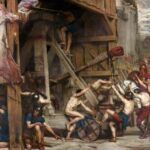Fortifications around Rome were built between 271 and 275 CE. The construction of the wall was ordered by Emperor Aurelian as a reaction to the Alan invasion of Italy in 268 CE, and it was completed by Emperor Probus. The walls enclosed all 7 hills of Rome, the Field of Mars and Trastevere on the west bank, one of the most important districts of Rome.
Despite repelling the barbarian invasion, the Romans still felt threatened, fearing that the old walls surrounding the city would not hold back another attack. So the emperor decided to build a new, much stronger belt of fortifications around the city. The entire construction of the walls took only a few years, thanks to the use of many existing structures, such as the Praetorian barracks, both time and funds were saved. In later years, the walls were expanded by subsequent rulers, for example, Maxentius or Honorius.
The fortifications covered Rome on the left bank of the Tiber and a small, fortified bridgehead on the right bank of the river. The wall was 19 km long and 6 to 8 meters high. Together, the fortifications encircled an area of 13.7 square kilometres. The wall was built mainly of brick-clad concrete, which differed from the republican walls. Its top was reinforced with battlements along which an obscured corridor ran.
Porte |
|








